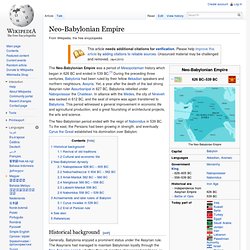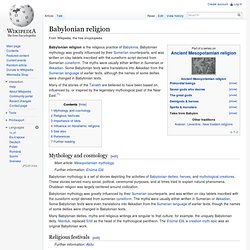

Neo-Babylonian Empire. The Neo-Babylonian Empire was a period of Mesopotamian history which began in 626 BC and ended in 539 BC.[1] During the preceding three centuries, Babylonia had been ruled by their fellow Akkadian speakers and northern neighbours, Assyria.

Yet, a year after the death of the last strong Assyrian ruler Assurbanipal in 627 BC, Babylonia rebelled under Nabopolassar the Chaldean. In alliance with the Medes, the city of Nineveh was sacked in 612 BC, and the seat of empire was again transferred to Babylonia. This period witnessed a general improvement in economic life and agricultural production, and a great flourishing of architectural projects, the arts and science.
The Neo-Babylonian period ended with the reign of Nabonidus in 539 BC. To the east, the Persians had been growing in strength, and eventually Cyrus the Great established his domination over Babylon. Historical background[edit] Generally, Babylonia enjoyed a prominent status under the Assyrian rule. Babylonian religion. Babylonian religion is the religious practice of Babylonia.

Babylonian mythology was greatly influenced by their Sumerian counterparts, and was written on clay tablets inscribed with the cuneiform script derived from Sumerian cuneiform. The myths were usually either written in Sumerian or Akkadian. Marduk. Marduk (Sumerian spelling in Akkadian: AMAR.UTU 𒀫𒌓 "solar calf"; perhaps from MERI.DUG; Biblical Hebrew מְרֹדַךְ Merodach; Greek Μαρδοχαῖος,[1] Mardochaios) was the Babylonian name of a late-generation god from ancient Mesopotamia and patron deity of the city of Babylon, who, when Babylon became the political center of the Euphrates valley in the time of Hammurabi (18th century BCE), started to slowly rise to the position of the head of the Babylonian pantheon, a position he fully acquired by the second half of the second millennium BCE.

In the city of Babylon, he resided in the temple Esagila.[2] According to The Encyclopedia of Religion, the name Marduk was probably pronounced Marutuk. In the perfected system of astrology, the planet Jupiter was associated with Marduk by the Hammurabi period.[4] Mythology[edit] Marduk and his dragon Mušḫuššu, from a Babylonian cylinder seal. List of kings of Babylon. The following is a list of the kings of Babylonia (ancient southern-central Iraq), compiled from the traditional Babylonian king lists and modern archaeological findings.

The Babylonian King List[edit] The Babylonian King List is not merely a list of kings of Babylon, but is a very specific ancient list of supposed Babylonian kings recorded in several ancient locations, and related to its predecessor, the Sumerian King List. As in the latter, contemporaneous dynasties are listed chronologically without comment. There are three versions, one known as "King List A"[1] (containing all the kings from the First Dynasty of Babylon to the Neo-Assyrian king Kandalanu) and "King List B"[2] (containing only the two first dynasties) and "King List C"[3] (containing the first seven kings of the Second Dynasty of Isin).
A fourth version was written in Greek by Berossus. Middle Bronze Age[edit] Early Amorite city-states[edit] Kings of Larsa[edit] Babylonian Empire (Middle Bronze Age)[edit] List of kings of Babylon. Babylonia. Babylonia was an ancient Akkadian-speaking Semitic nation state and cultural region based in central-southern Mesopotamia (present-day Iraq).

It emerged as an independent state c. 1894 BC, with the city of Babylon as its capital. It was often involved in rivalry with its fellow Akkadian state of Assyria in northern Mesopotamia. Babylonia became the major power in the region after Hammurabi (fl. c. 1792 - 1752 BC middle chronology, or c. 1696 – 1654 BC, short chronology) created an empire out of many of the territories of the former Akkadian Empire. The Babylonian state retained the written Semitic Akkadian language for official use (the language of its native populace), despite its Amorite founders and Kassite successors not being native Akkadians. It retained the Sumerian language for religious use, but by the time Babylon was founded this was no longer a spoken language, having been wholly subsumed by Akkadian.